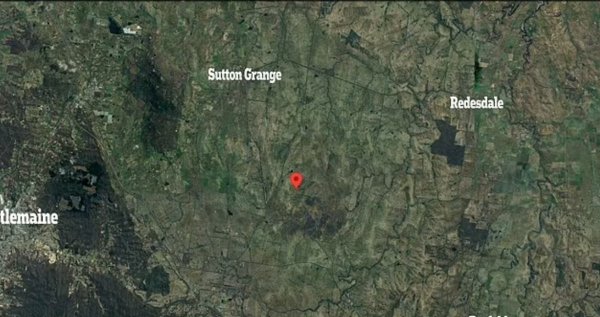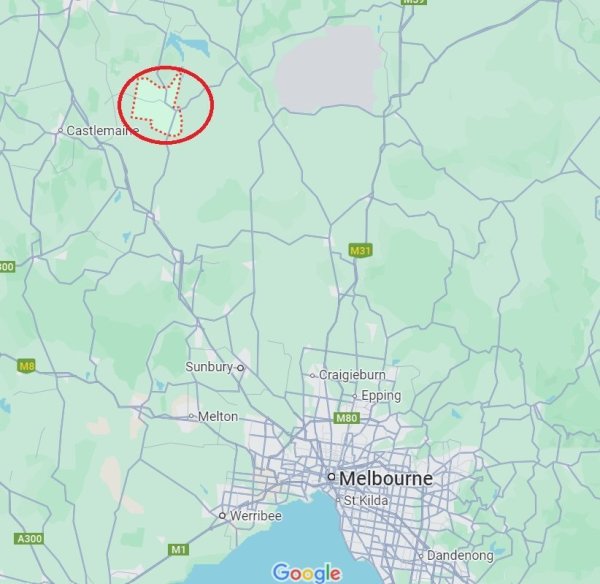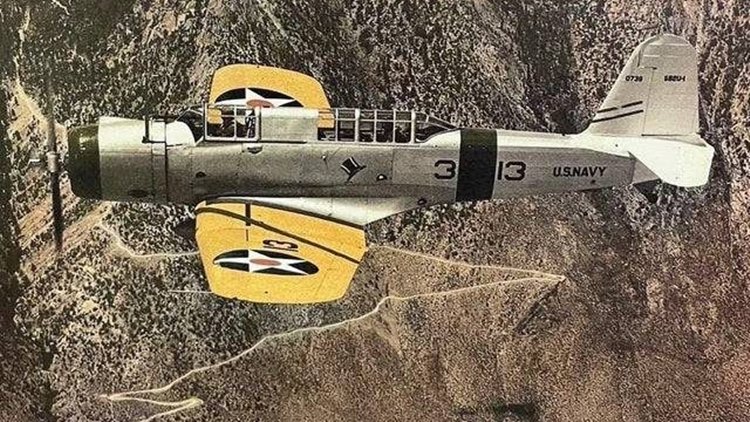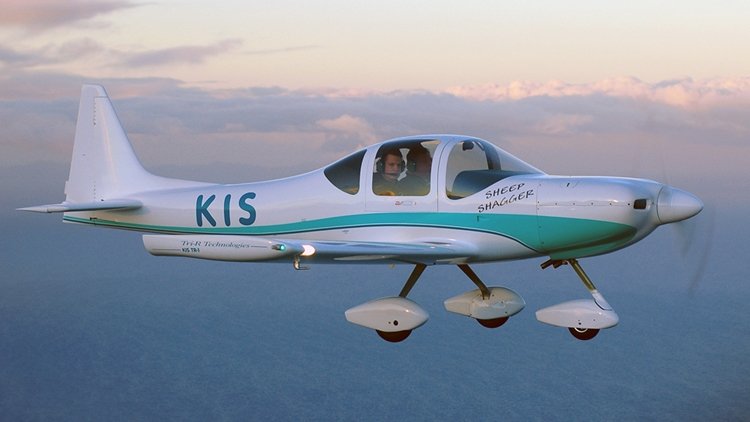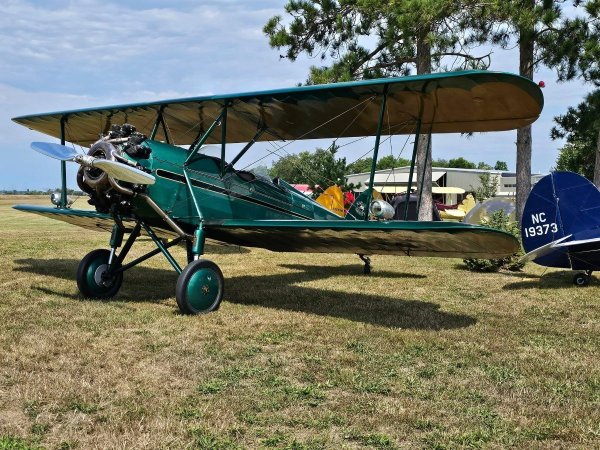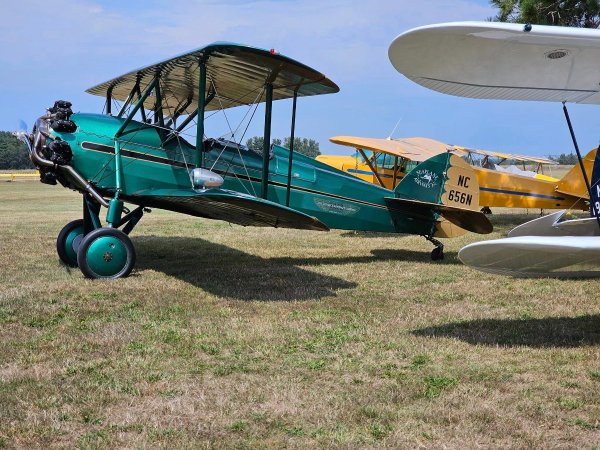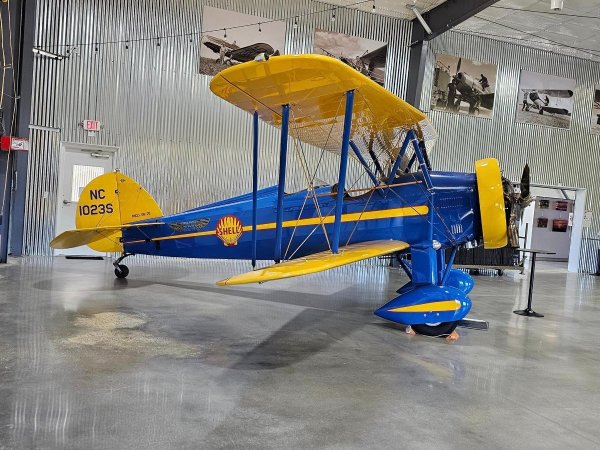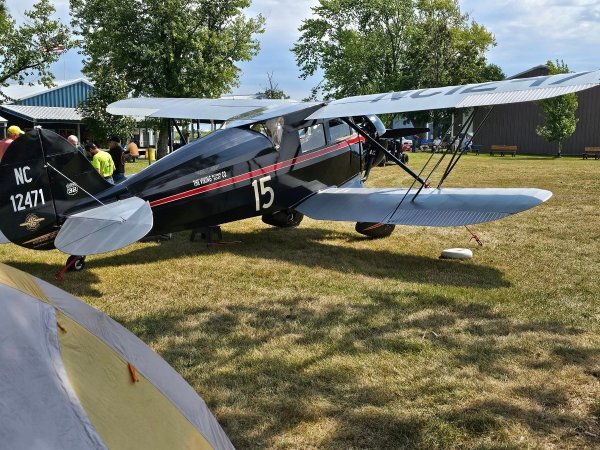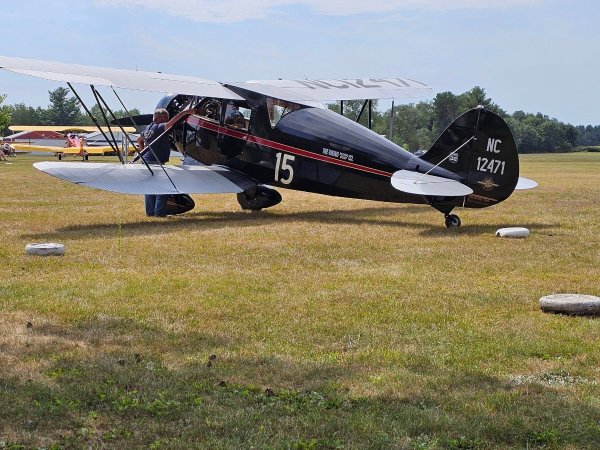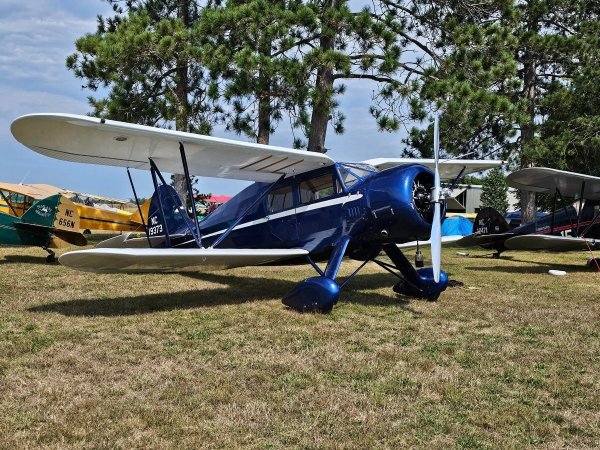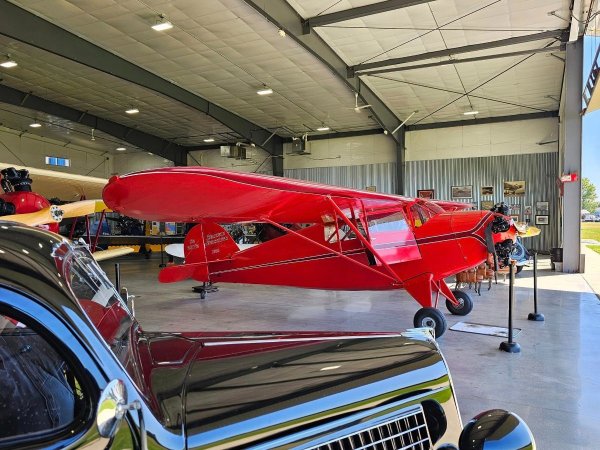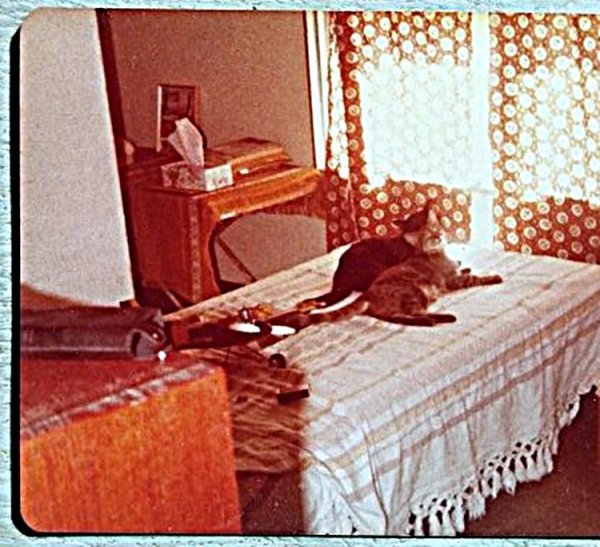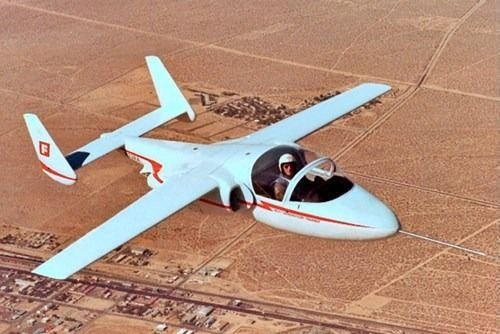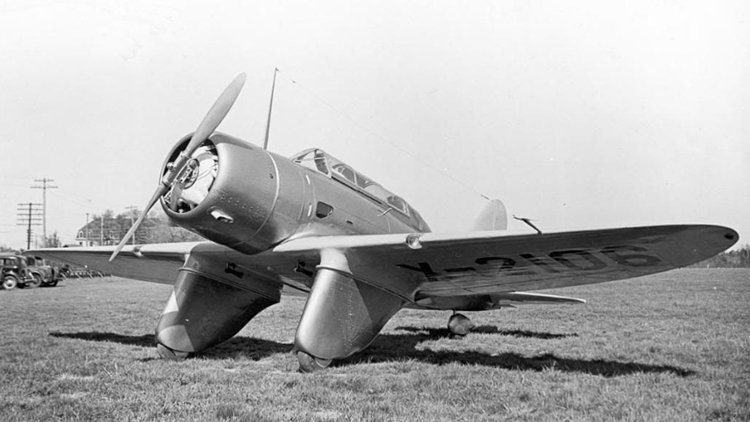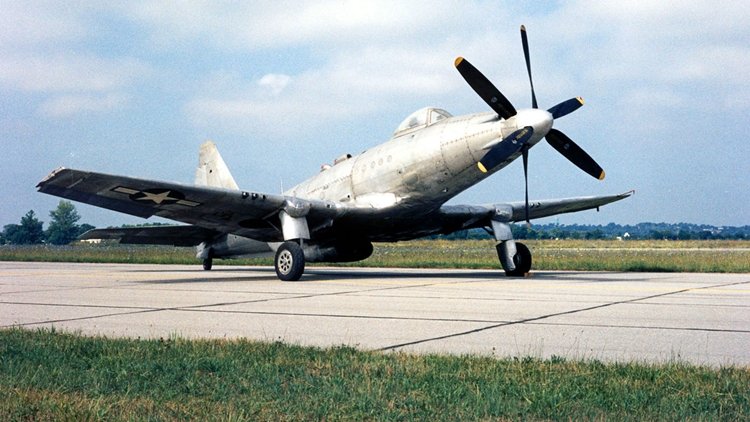-
Posts
7,574 -
Joined
-
Last visited
-
Days Won
67
Content Type
Profiles
Forums
Gallery
Downloads
Blogs
Events
Store
Aircraft
Resources
Tutorials
Articles
Classifieds
Movies
Books
Community Map
Quizzes
Videos Directory
Everything posted by red750
-
I think I might predate you Jerry. I learnt at Moorabbin before the days of RAA and recreational certificates. My school no longer exists - I learnt at Civil Flying School and Peter Bini was the CFI. He did my checkride for the resttricted PPL in 1968. Then I did my navexes and did a couple of landings at Lilydale on the grass strips on my way to unrestricted PPL. Lilydale was owned by CFS in those days, and started with the "office" in a caravan parked near the southern end of the runways. Later they built a two storey clubhouse where the current school is located, but it burned down. Flew Musketeers, Warrior, Arrow, Bonanza,Airtourer. Got nplenty of radio experience at Moorabbin.
-
I haven't been near Tulla since 2017, but when I did go, the spot I loved to take photos like the one below will most likely be behind a locked gate.
-

Light plane crash Redesdale Vic 13/09/24 One dead.
red750 replied to red750's topic in Aircraft Incidents and Accidents
-

Light plane crash Redesdale Vic 13/09/24 One dead.
red750 replied to red750's topic in Aircraft Incidents and Accidents
Channel 7 report showing burnt out wreckage from helicopter view. Channel 7 report -
Third Runway Approved WWW.MELBOURNEAIRPORT.COM.AU
-
A light plane has crashed near a rural town in Victoria. Police and paramedics rushed to the scene near Redesdale, a small town 100km northwest of Melbourne, after the plane crashed at 12.35pm on Friday. One person has died, the Herald Sun reports. The plane crashed in paddocks, and police have reportedly blocked access to a rural property in the area as their investigations begin. A Victoria Police spokesperson said: 'The exact circumstances surrounding the incident are yet to be determined, more information will be provided when it is appropriate to do so'.
-
Posted by Admin on Social Australia: Nev is recovering from his Knee surgery in rehab so he will be back with Bells on very soon. Life would not be the same without Nev
-
1.5M views · 11K reactions | "When nature calls, sometimes you just... WWW.FACEBOOK.COM "When nature calls, sometimes you just have to answer—no matter where you are! Imagine having to make an off-field landing for a quick 'emergency stop'? 😅" Wishing you blue skies, tailwinds, and...
-
Thanks T510.
-
-
The Vought SB2U Vindicator is an American carrier-based dive bomber developed for the United States Navy in the 1930s, the first monoplane in this role. Vindicators still remained in service at the time of the Battle of Midway, but by 1943, all had been withdrawn to training units. It was known as the Chesapeake in Royal Navy service. In 1934, the United States Navy issued a requirement for a new Scout Bomber for carrier use, and received proposals from six manufacturers. The specification was issued in two parts, one for a monoplane, and one for a biplane. Vought submitted designs in both categories, which would become the XSB2U-1 and XSB3U-1 respectively. The biplane was considered alongside the monoplane design as a "hedge" against the U.S. Navy's reluctance to pursue the modern configuration. The XSB2U-1 was of conventional low-wing monoplane configuration with a retractable conventional tailwheel landing gear, the pilot and tail gunner being seated in tandem under a long greenhouse-style canopy. The fuselage was of steel tube construction, covered with aluminum panels from the nose to the rear cockpit with a fabric-covered rear fuselage, while the folding cantilever wing was of all-metal construction. A Pratt & Whitney R-1535 Twin-Wasp Junior radial engine drove a two-blade constant-speed propeller, which was intended to act as a dive brake during a dive bombing attack. The use of propeller braking was not entirely successful, and in practice US Navy Vindicators lowered the aircraft's undercarriage to act as a speed brake and dived at shallower angles. A single 1,000 lb (450 kg) bomb could be carried on a swinging trapeze to allow it to clear the propeller in a steep dive, while further bombs could be carried under the wings to give a maximum bombload of 1,500 lb (680 kg). For more details of design and development, operational history and eight variants, click here.
-
The Tri-R KIS TR-1 is an American homebuilt aircraft that was designed by Rich Trickel and produced by Tri-R Technologies of Oxnard, California, introduced in the 1990s. When it was available the aircraft was supplied as a kit for amateur construction. Trickel's main business was High Tech Composites, a company that produced many airframe components under sub-contract for kit aircraft such as the Lancair 235, Lancair 320 and Lancair IV. Trickel originally drew a new aircraft as a set of three-views for a customer in Australia who was looking for a new, conventional aircraft concept. The customer liked the design, but never paid for the drawings, so Trickel brought them home and completed the design work himself. Eventually the new design became the KIS TR-1. The KIS TR-1 features a cantilever low-wing, a two-seats-in-side-by-side configuration enclosed cockpit accessed via gull-wing doors, fixed tricycle landing gear or optionally conventional landing gear with wheel pants and a single engine in tractor configuration. The aircraft is made from composites. Its 23.00 ft (7.0 m) span rectangular wing employs a NACA 63-215 airfoil, mounts flaps and has a wing area of 88.00 sq ft (8.175 m2). The acceptable power range is 80 to 125 hp (60 to 93 kW) and the standard engines used are the 125 hp (93 kW) Continental O-240, the 108 hp (81 kW) Lycoming O-235-C1B or the 80 hp (60 kW) Limbach L2000 powerplant. The KIS TR-1 has a typical empty weight of 750 lb (340 kg) and a gross weight of 1,300 lb (590 kg), giving a useful load of 550 lb (250 kg). With full fuel of 20 U.S. gallons (76 L; 17 imp gal) the payload for the pilot, passenger and baggage is 430 lb (200 kg). The standard day, sea level, no wind, take off with a 125 hp (93 kW) engine is 600 ft (183 m) and the landing roll is 1,200 ft (366 m). Variants KIS TR-1 (Specifications below) Original model with tricycle landing gear and a gross weight of 1,300 lb (590 kg). By 1998 the company reported that 25 aircraft were completed and flying. In March 2014 ten examples were registered in the United States with the Federal Aviation Administration, although a total of 13 had been registered at one time.[3] Also in March 2014 there were seven registered in the United Kingdom with the CAA. KIS TR-1/TD Conventional landing gear-equipped version ("Taildragger"), with an empty weight of 800 lb (360 kg) and a gross weight of 1,425 lb (646 kg). Fuel is 34 U.S. gallons (130 L; 28 imp gal). By 1998 the company reported that eight aircraft were completed and flying. The manufacturer estimated the construction time from the supplied kit as 1000 hours. Tri-KIS TR-1/TD
-
-
The Taildragger Group on Facebook posted some great photos which I have downloaded and posted here. This is just half of them. I will post the rest later. They have not been resized or altered in any way. Click on them to see the full sized version.
-
This one never made it off the drawing board. No prototype built. The Nakajima G10N Fugaku (Japanese: 富岳 or 富嶽, "Mount Fuji") was a planned Japanese ultra-long-range heavy bomber designed during World War II. It was conceived as a method for mounting aerial attacks from Japan against industrial targets along the west coast (e.g., San Francisco) and in the Midwest (e.g., Detroit, Milwaukee, Chicago, and Wichita) and the northeast (e.g., New York City and Norfolk) of the United States. Japan's worsening war situation resulted in the project's cancellation in 1944. The Fugaku had its origins in "Project Z (bomber project)", a 1942 Imperial Japanese Army specification for an intercontinental bomber which could take off from the Kuril Islands, bomb the contiguous United States, then continue onward to land in German-occupied France. Once there, it would be refueled and rearmed and make another return sortie. Project Z called for three variations on the airframe: heavy bomber, transport (capable of carrying 300 troops), and a gunship armed with forty downward-firing machine guns in the fuselage for intense ground attacks at the rate of 640 rounds per second (i.e. 38,400 rounds per minute). The project was conceived by Nakajima Aircraft Company head Chikuhei Nakajima. The design had straight wings and contra-rotating four-blade propellers. To save weight, some of the landing gear was to be jettisoned after takeoff (being unnecessary on landing with emptied bomb load), as had been planned on some of the more developed German Amerika Bomber competing designs. It used six engines,[1] as with the later Amerikabomber design competitors, to compensate for nearly all German aircraft engines being limited to 1,500 kW (2,000 hp) maximum output levels apiece. Development was initiated in January 1943 and a design and manufacturing facility built in Mitaka, Tokyo. Nakajima's 4-row 36-cylinder 5,000 hp Ha-54 (Ha-505) engine was abandoned as too complex. Flightsim image.
-
The Breda-Zappata B.Z.308 was an Italian four-engined airliner produced by Breda. It was conceived by the engineer Filippo Zappata in 1942, still in time war, with all the problems connected to the priorities of the moment, so much so that the September 8, 1943 only the fuselage of the prototype was built. In the period 1944-45 the work was blocked first by the Germans and, at the end of the conflict, by the Allies, whose Allied Armistice Commission prohibited the continuation of any aeronautical project until the beginning of 1946 The B.Z.308 was a four-engined civil transport developed in the late 1940s for operation over both European and transatlantic routes. A large low-wing monoplane of all-metal construction, it was powered by four Bristol Centaurus radial engines driving five-bladed propellers. It had a large tailplane with endplate fins and rudders, and had retractable landing gear. The fuselage, oval in cross-section, accommodated a flight crew of five and 55 passengers in two cabins; a high-density model was planned with seats for 80. In early 1946 the work resumed, also slowed down by British resistance to delivering the needed engines, so the aircraft was completed in June 1946 and the first flight took place on August 27, 1948. V.Meleca Construction began during 1946, under aircraft designer Filippo Zappata at Breda's Sesto San Giovanni works. The Allied Commission halted the work, which was not resumed until January 1947. Further delays in the delivery of Bristol Centaurus engines delayed the first flight, which was on 27 August 1948, piloted by Mario Stoppani. Although flight testing went well, the project was abandoned as a result of financial problems, anticipated competition from American airliners in the postwar market, and pressure (under the Marshall Plan) to close down Breda's aeronautical section. Breda subsequently stopped producing aircraft entirely. Only the one was produced. Maximum speed: 573 km/h (356 mph, 309 kn) Cruise speed: 441 km/h (274 mph, 238 kn) at 4,300 m (14,100 ft) Stall speed: 135 km/h (84 mph, 73 kn) Range: 7,700 km (4,800 mi, 4,200 nmi) Service ceiling: 8,000 m (26,000 ft)
-
Hi Danny. I have no idea why you are having such problem with you images. I have played around with them a bit - rotate, crop, adjust colour. Then I cropped down to just the plane.
-
Two NASA astronauts will endure months of intense radiation exposure after Boeing's Starliner spacecraft stranded them on the International Space Station. Astronauts Sunita Williams and Barry Wilmore have been stuck on the ISS for three months. This has already put them at risk of receiving about 40 mSv to 80 mSv of radiation, which is roughly equivalent to 120 to 240 chest x-rays. They won't return to Earth until February 2025 at the earliest, and will have spent at least eight months in space and risked radiation exposure roughly equivalent to 310 to 630 chest x-rays. Studies have shown that doses of radiation at that level increase long-term risk of cancer, cardiovascular disease and central nervous system damage, according to NASA.
-
The Fairchild T-46 was an American light jet trainer aircraft of the 1980s. It was cancelled in 1986 with only three aircraft being produced due to cost over-runs and budget cuts.
-
The Seversky SEV-3 was an American three-seat amphibian monoplane, the first aircraft designed and built by the Seversky Aircraft Corporation. The SEV-3 was an all-metal cantilever low-wing monoplane powered by a nose-mounted 420 hp (313 kW) Wright J-6 Whirlwind radial engine. It had two cockpits in tandem, a forward cockpit for the pilot and a rear cockpit for two passengers, both with sliding canopies. It could either be fitted with twin amphibious floats which had main wheels fitted in the floats to allow it to operate from land, or with a fixed tailwheel undercarriage with the mainwheels enclosed in large fairings. The SEV-3 first flew as a floatplane in June 1933, demonstrating excellent performance as both an amphibian and a landplane. It was built in small numbers mainly for export. An SEV-3 established a world speed record for piston-engined amphibians in 1933, and on 15 September 1935, a Wright Cyclone-powered SEV-3 set a record of 230 mph (370.8 km/h) which stood for 49 years. A landplane version was also developed with conventional landing gear. The design influenced a long line of Seversky and later Republic aircraft, eventually leading to the development of the P-47 Thunderbolt. A landplane version was used by the United States Army Air Corps as a basic trainer with the designation BT-8, 30 of which were ordered in 1935. This proved grossly underpowered and was quickly replaced by the North American BT-9. One BT-8 was delivered to Bolling Field, on 11 June 1936, for use by Chief of the Air Corps Major General Oscar Westover, and assigned to the 14th Bombardment Squadron, GHQ Air Force. It replaced an O-38F, which was reassigned to the 21st Observation Squadron, GHQ Air Force, for general flying. Variants SEV-3XAR Landplane trainer SEV-3XLR Landplane SEV-3M-WW Amphibian for the Colombian Air Force, six built (only delivered four to Colombia), with Wright Whirlwind engines. BT-8 (Specifications below) Landplane basic-trainer for the United States Army Air Corps, developed from SEV-3XAR. 30 built. SEV-X-BT multi-discipline trainer version of the BT-8 with retractable undercarriage. The sole SEV-X-BT lost in competition to the North American BT-9 and was reportedly scrapped for spares to service the Seversky 2PA.
-
The Fisher P-75 Eagle was an American fighter aircraft designed by the Fisher Body Division of General Motors. Development started in September 1942 in response to United States Army Air Forces requirement for a fighter possessing an extremely high rate of climb, using the most powerful liquid-cooled engine then available, the Allison V-3420. The program was cancelled after only a small number of prototypes and production aircraft had been completed, as it was no longer required in its original role, could not be quickly deployed, and possessed no significant advantages over aircraft already in production/ In October 1942, the contract for two prototypes, designated "XP-75", was signed with the Fisher Body Division of GM. The design concept was to use the outer wing panels from the North American P-51 Mustang, the tail assembly from the Douglas A-24 (SBD), and the undercarriage from the Vought F4U Corsair in a general layout much as in the Bell P-39 Airacobra with the engine located amidships with the contra-rotating propellers driven through extension shafts. At an early design stage, however, Curtiss P-40 Warhawk outer wing panels were substituted for the P-51 panels. In mid-1943, the need for long-range escort fighters became more urgent than fast climbing interceptors so a decision was made to order six more XP-75 airplanes modified for the long-range role. At this time, an order for 2,500 production aircraft was also let, but with the stipulation that if the first P-75A was not satisfactory the complete order might be canceled. At the time, General Motors was busy in several projects towards the war effort, including the mass production of several different aircraft types, among them the Grumman TBF Avenger. Some sources[2] claim that the P-75 was the result of a scheme to get General Motors out of being forced to build Boeing B-29 Superfortresses; the P-75 project being a "high-priority" project to help GM avoid the added strain of Superfortress production. The "Eagle" was given extensive media coverage prior to its first flight, being trumpeted as a "wonder plane". Powered by a V-3420-19 24-cylinder engine rated at 2,600 hp (1,900 kW) driving co-axial contra-rotating propellers, the XP-75 flew for the first time on 17 November 1943. The second XP-75 flew shortly thereafter, with all six long-range XP-75s entering the test program by the spring 1944. The test program brought up numerous teething problems, including miscalculation of the fighter's center of mass, failure of the engine to produce its expected power, inadequate engine cooling, high aileron forces at high speed, and poor spin characteristics. Redesigns were introduced into the long-range XP-75s including a modified tail assembly, new "bubble" canopy, and a V-3420-23 engine that corrected most of the deficiencies by the time the first P-75A Eagles entered flight testing in September 1944. By this time, the Army Air Forces had decided to limit the number of combat aircraft types in production and not enter into large-scale production of new types that might not be available before the war ended. As the twin-engine Lockheed P-38 Lightning and North American P-51 Mustang demonstrated excellent long-range capabilities, the production run of the P-75A Eagle was subsequently terminated on 6 October 1944. It was decided to use the six completed production aircraft for experimental work and development of the V-3420 engine. As a result of those events, the P-75A did not complete formal performance trials due to termination of the production contract. Ultimately, only eight XP-75s and six P-75As were built.
-
The Dassault Falcon 2000 is a business jet produced by French Dassault Aviation, a member of its Falcon business jet line. Developed from the Falcon 900 trijet, the smaller twinjet has less range. The Falcon 900 fuselage was shortened by 7 ft (2.1 m) to carry up to 10 passengers. The wing leading edge was modified and its inboard slats were removed. It was introduced in 1995 for $17.85 million, while the 2023 Falcon 2000LXS lists for $36 million. Variants Falcon 2000 Original version certified in 1994[4] with CFE (General Electric & AlliedSignal) CFE738-1-1B turbofans,[5][6] with 5,918 pounds-force (26.32 kilonewtons) of thrust each, a range of 2,841 nautical miles [nmi] (5,262 km; 3,269 mi) range and Collins Pro Line 4 avionics suite.[2] Falcon 2000EX Re-engined variant certified in 2003 with Pratt & Whitney Canada PW308C turbofan engines,[5] 7,000 lbf (31 kN) each, offering a 3,878 nmi (7,182 km; 4,463 mi) range. Falcon 2000EX EASy Marketing designation for a 2000EX with changes to pressurisation and oxygen systems, certified in 2004, and Honeywell Primus Epic-based EASy avionics suite, including synthetic vision. Undertook steep approach trials at London City Airport on 18 March 2010, becoming the first Dassault twin-jet to visit apart from the much older, diminutive Dassault Falcon 10. Falcon 2000DX Updated model certified in 2007[4] and based on the 2000EX EASy with the same PW308C turbofans. Shorter-range of 3,250 nmi (6,020 km; 3,740 mi) for $28.5 million. Falcon 2000LX Longer-range 2000 variant of the Falcon 2000EX EASy, with the addition of Aviation Partners Blended Winglets, giving it a range capability of 4,000 nautical miles (7,400 km; 4,600 mi).[8] The same winglets are certified for the entire Falcon 2000 series as a retrofit kit. Falcon 2000S Variant which began testing in 2011 with short field characteristics. Landing distance has been reduced to 705 meters, opening up 50% more airports than other aircraft in this class. Compared to the $5 million more expensive LXS, the S range is shorter by 500 mi (800 km; 430 nmi) by restricting its fuel capacity to 14,600 lb (6,600 kg). It burns 2,350–2,400 lb (1,070–1,090 kg) of fuel in the first hour and 1,600–1,650 lb (730–750 kg) afterwards, and can take off in 4,325 ft (1,318 m) at sea level on a standard day. In 2021, its equipped price was $28.8M. It offers a 3,350 nmi (6,200 km; 3,860 mi) range. Falcon 2000LXS (Specifications below) Replacement for the long-range 2000LX and introduced in 2014. Relative to its predecessor, the Falcon 2000LXS offers greatly improved takeoff and landing performance, superior cabin comfort and reduced emissions. It also has a lower approach speed (194 km/h vs. 210 km/h), enabling it to land in a shorter distance, 689 m vs. 800 m, equivalent to turboprop aircraft. In 2021, its equipped price was $35.1M. Falcon 2000MRA/MSA The Maritime Reconnaissance Aircraft (MRA) or Maritime surveillance aircraft (MSA) is a militarized variant based on the Falcon 2000LXS. Six Falcon 2000MSA were ordered by the Japan Coast Guard in 2015, with delivery expected from 2019 onwards. Falcon 2000 Albatros Derived from the Falcon 2000MRA, the Falcon 2000 Albatros was selected in 2020 to replace the French Naval Aviation's Falcon 50 Surmar and Falcon 200 Gardian aircraft. The aircraft is designed for maritime surveillance and intervention missions. It will incorporate a multifunction under-fuselage radar, a high-performance electro-optical/infrared (EO/IR) system, observation windows, a Search & Rescue chain release system and dedicated communications systems. Seven units have been ordered and are to be delivered from 2025 onwards, with the acquisition of five additional units planned for a total of twelve aircraft.




